These two parks can be considered as prairie parks. They are located close together in north Calgary and you can actually look from one into the other. Nose Hill is the highest point in Calgary and you have clear view of the downtown with Calgary Tower.
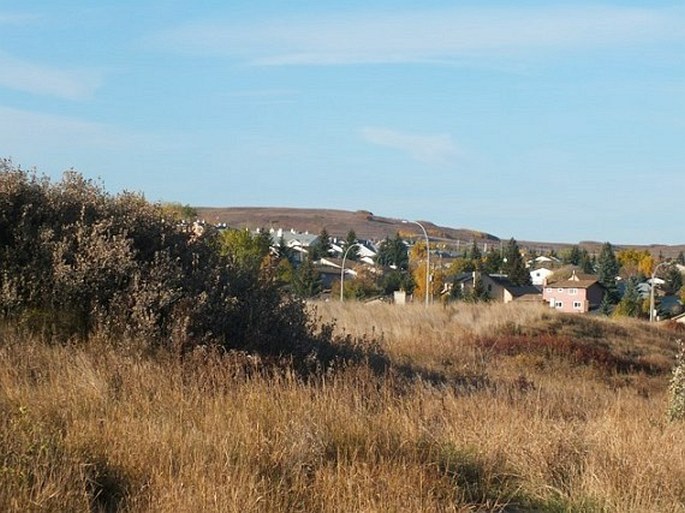
- Confluence Park (West Nose Creek Confluence Park)
West Nose Creek meanders through the valley of Confluence Park, however Nose Creek flows from the north along Deerfoot Trail, a major highway through the city, and the confluence of these two creeks happens just outside the park. Just under the Deerfoot Trail you notice a couple of sloughs where you can see a variety of water fowl, especially the uncommon Black-crowned Night Herons (Nycticorax nycticorax). Swainson’s Hawks (Buteo swainsoni) are also present, feeding on Wandering Garter Snakes (Thamnophis elegans vagrans). Besides a variety of birds, this park is a treasure of native plants, from very spring until late autumn. Along the meanders of the creek, wetland and riverine plants thrive. Water Hemlock (Cicuta maculata), our most poisonous plant can be seen here in abundance, Nuttal’s Sunflower (Helianthus nuttallii), graces the banks of the creek, Sandbar Willow (Salix exigua) grows in wet places and along the Cicuta you find Marsh Hedgenettle (Stachys pilosa) in abundance. Also Western Willow Aster (Symphyotrichum lanceolatum) is quite common and our rare Lance-leaved Ironplant (Pyrrocoma lanceolata), can be found here.

Once you ascend the slopes of the valley, you are in the dry zone and you can be dazzled in early spring by beauty of Smooth Blue Beardtongue (Penstemon nitidus), which loves the dry bare slopes, together with lovely Yellow Prairie Violet (Viola nuttallii). You can amazed of the subdued beauty of flowers of milkvetches like Cushion Milkvetch (Astragalus gilviflorus) and Grounplum Milkvetch (Astragalus crassicarpus). Golden Bean (Thermopsis rhombifolia) grows everywhere, adding yellow colour to the grass. An uncommon beauty is a Narrow-leaved Four-o’clock (Mirabilis linearis) in the protection of rocks.
And finally two specialties to show off: on the exposed, sandstone cliffs, exposed to the sun, you can find cushions of Creeping Nailwort (horrible common name – Paronychia sessiliflora), unusually unique plant, and the other lovely but totally unpretentious, tiny plant of Little Rose (Chamaerhodos erecta).
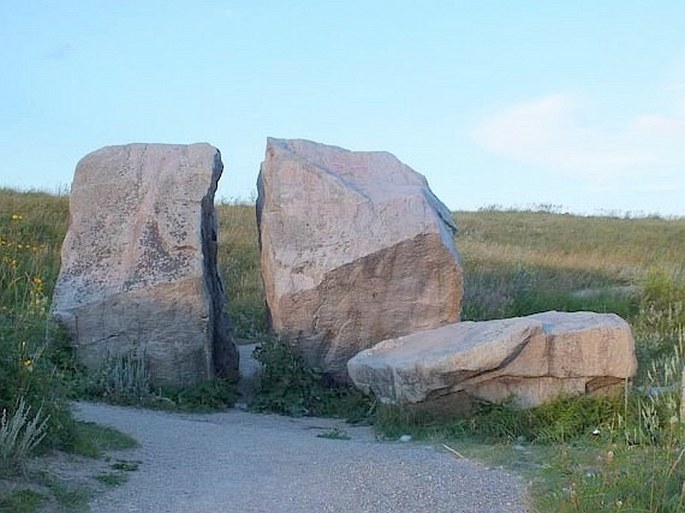
The ubiquitous shrubs include Choke Cherry (Prunus virginiana), Saskatoon Serviceberry (Amelanchier alnifolia) and Silverberry (Elaeagnus commutata). Large areas of grassland are densely covered by Buckbrush (Symphoricarpos occidentalis), named as such for it is a favoured food of deer. Prairie Rose (Rosa arkansana) is dotting the landscape with pink flowers a red hips.
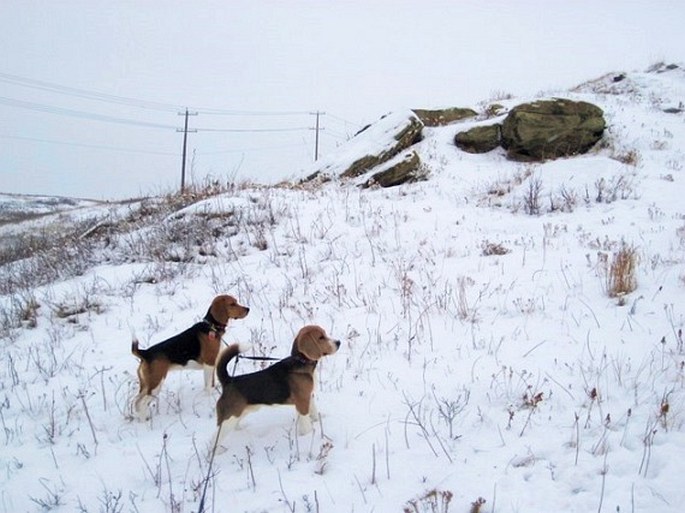
The terrain of the park is great for walking or jogging or even dog walking or just for its beauty. If you want to make it a longer trip, walk the length of the park and see the Split Rock, a glacial erratic boulder, which is indeed split in two and used to be a subject to divination by the native people and rubbing stone for migrating bison.
Like any other park anywhere, it cannot be without invasive weeds. This park has a problem with several ones: Yellow Clematis (Clematis tangutica), Creeping Thistle (Cirsium arvense), Smooth Brome grass (Bromus inermis), and ever present Goat’s Beard (Tragopogon dubius and T. pratensis).
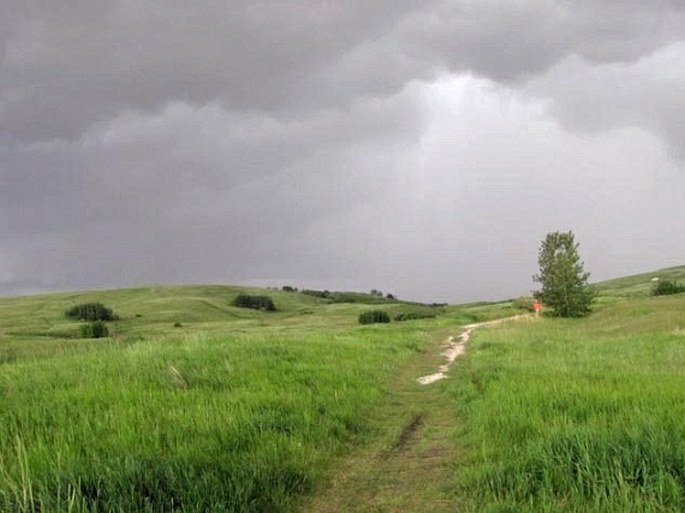
- Nose Hill Park (Nose Hill natural Environment Park)
In 1969 you were able to drive your car to the top of the highest hill in Calgary for the view of the city, which had population of slightly over 300 000 people. In 1973, the Nose Hill became an official park and now in the city of over 1 million people, you have to climb the hill on foot. It is quite worth it. This is a real prairie park, without any permanent water streams, only rain run off through the coulees (ravine or gully) and along the trails.
The sandstone quarry in a part of the hill had been a source of construction sandstone used for building the early Calgary (known at the time as Sandstone City). Until today blocks of sandstone are scattered al over the park.
They are not the only rocks to be seen. The Rubbing Stone is large boulder, glacial erratic, used by overwintering bison for rubbing their shedding coat off. By its composition this rock’s origin can be traced to Mt. Edith Cavell in Jasper National Park.
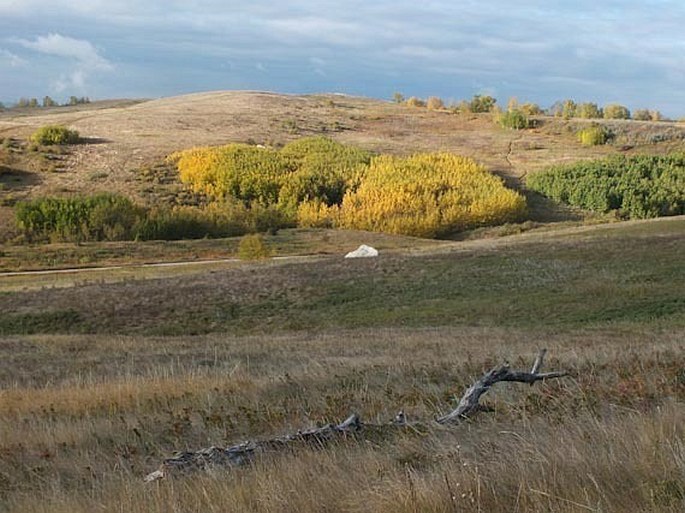
This park is favoured for walking the dogs. But with a certain danger, as coyotes (Canis latrans) are present and might attack your pet. Northern slopes are covered with Quaking Aspen groves (Populus tremuloides) and host Canadian Porcupine (Erethizon dorsatum) and if you are lucky you can find enough mushrooms like Aspen Boletes (Leccinum insigne) for a meal. White-tailed Deer (Odocoileus virginianus) is not uncommon.
The gopher, correctly named Richardson’s Ground Squirrel (Urocitellus richardsonii) typical prairie rodents are present as well. Northern Pocket Gopher (Thomomys talpoides) is seldom seen from its underground home but his mounds can be seen all over the park and are mistakenly identified as mole hills (moles do not live here). A variety of birds can satisfy any birder.
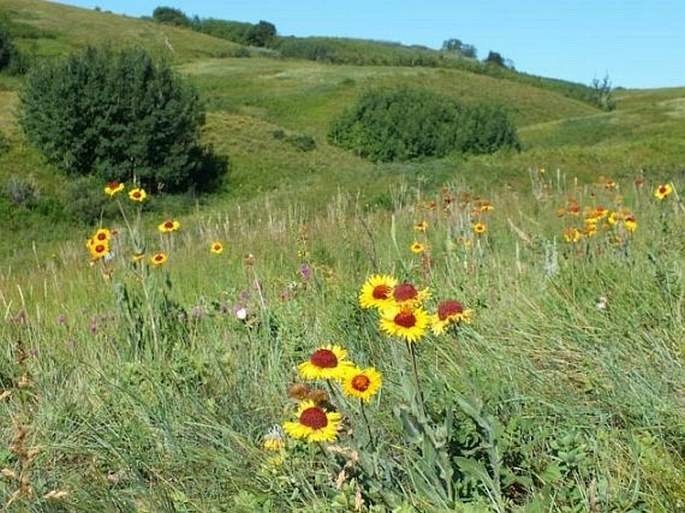
As we are concerned with botany, let’s mention the most common and the least common. The prairies are not rich in trees. As far as grasses are concerned, Alberta Provincial grass, Rough Fescue (Festuca altaica) grows in typical hummocks or tussocks on the slopes and lovely Blue Grama also known as Granny’s Eyebrows (Bouteloua gracilis) is found right through the park.
As mentioned before Quaking Aspen grows on the northern slopes where more moisture is available. Along the seasonal drainage we can see Balsam Poplar (Populus balsamifera). A few willows (Salix spp.) can be seen there and in thickets, Silverberry (Elaeagnus commutata), scattered Choke Cherries (Prunus virginiana) and Saskatoon Serviceberry (Amelanchier alnifolia), plenty of Prairie Rose (Rosa arkansana) and along the trails Prickly Rose (Rosa acicularis). Large areas of grassland are densely covered by Buckbrush (Symphoricarpos occidentalis). Strikingly beautiful Blanket Flower (Gaillardia aristata) is plentiful here.
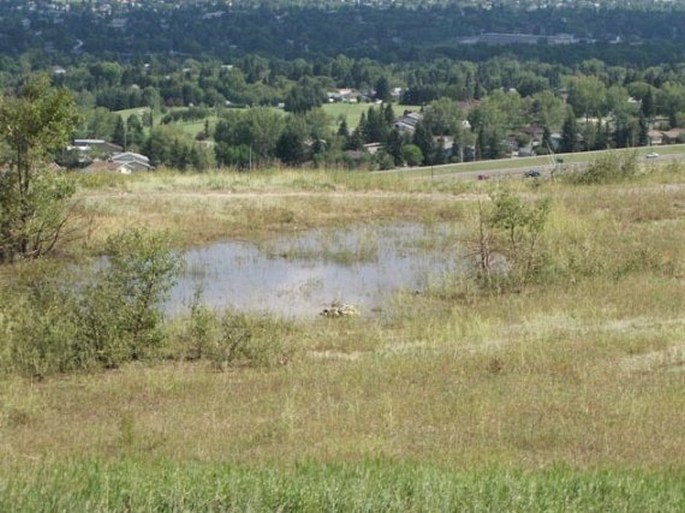
Scattered around the park you find some oddities. Out of its range, there are a few specimens of Prairie Yucca (Yucca glauca), on rare occasion you can see it bloom. Drummond’s Milkvetch (Astragalus drummondii) grows close to the Rubbing Stone, on a dry slope. In the grass there are a few surprises like Scarlet Globemallow (Sphaeralcea coccinea), Scarlet Butterfly Weed (Gaura coccinea), Desert Ragwort (Senecio eremophilus) and patches of Missouri Goldenrod (Solidago missouriensis). Green Bracted Orchid (Coeloglossum viride) can be found in several places and to our surprise, we recently found, just on the side of a main trail, in the gravel, several specimens of Yellow Lady’s-slipper Orchid (Cypripedium parviflorum).
No park is spared of invasive species. Even here you have to live with patches of thistles (Cirsium spp. and Carduus nutans), Smooth Brome grass (Bromus inermis), Goat’s Beard (Tragopogon dubius and T. pratensis) and even a spreading site of Sea Buckthorn (Hippophae rhamnoides).
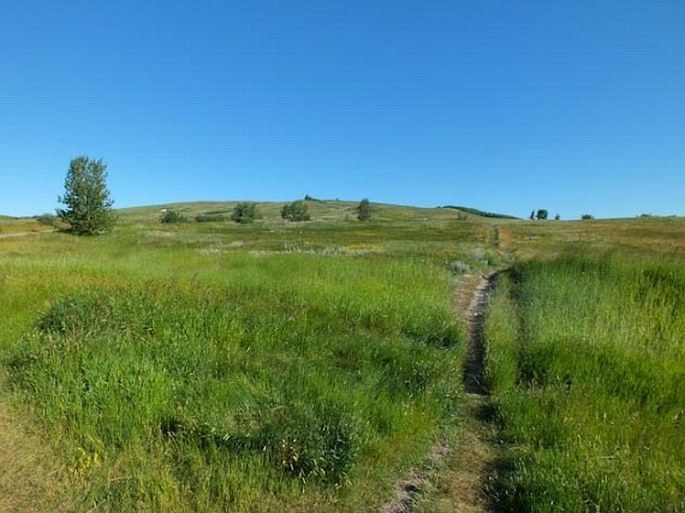
Sampler of plants in Confluence and Nose Hill parks:
Acer negundo – Manitoba Maple
Actaea rubra – Red Baneberry
Allium textile – Prairie Onion
Androsace septentrionalis – Pygmy Rockjasmine
Anemone canadensis – Canada Anemone
Anemone multifida – Cut-levaed Anemone
Arabis glabra – Tower Cress
Arabis holboellii – Reflexed Rock cress
Arctostaphylos uva-ursi – Common Bearberry
Astragalus adscendens – Purple Milkvetch
Astragalus crassicarpus – Groundplum Milkvetch
Astragalus drummondii – Drummond’s Milkvetch
Astragalus gilviflorus – Cushion Milkvetch
Betula occidentalis – Water Birch
Bouteloua gracilis – Blue Gramma
Calamovilfa longifolia – Sand Grass
Capsella bursa-pastoris – Shepherd’s Purse
Carex filifolia – Thread-leaved Sedge
Carex inops – Sun-loving Sedge
Carum carvi – Common Caraway
Cerastium arvense – Chickweed
Chamaerhodos erecta – Little Rose
Cicuta maculata – Water Hemlock
Comandra umbellata – Bastard Toad-flax
Corydalis aurea – Golden Corydalis
Cotoneaster acutifolia – Peking Cotoneaster
Cypripedium parviflorum – Yellow Lady’s-slipper Orchid
Dodecatheon conjugens – Shooting Star
Equisetum arvense – Field Horsetail
Eriogonum flavum – Yellow Buckwheat
Erysimum inconspicuum – Shy Wallflower
Festuca altaica – Rough Fescue
Gaillardia aristata – Blanket Flower
Gaura coccinea – Scarlet Butterfly Weed
Geum triflorum – Three-flowered Avens
Hedysarum boreale – Northern Hedysarum
Helianthus nuttallii – Nuttal’s Sunflower
Hesperostipa comata – Needle and Thread
Hippuris vulgaris – Common Mare’s-tail
Lesquerella arenosa – Sand Bladderpod
Linum lewisii – Prairie Flax
Linum rigidum – Yellow Flax
Lithospermum incisum – Narrow-leaved Stoneseed
Lithospermum ruderale – Wooly Gromwell
Maianthemum stellatum – Little False Solomon’s-seal
Mirabilis linearis – Narrow-leaved Four-o’clock
Muhlenbergia richardsonis – Mat Muhly
Musineon divaricatum – Leafy Wildparsley
Oxytropis sericea – Early Yellow Locoweed
Packera cana – Prairie Groundsel
Paronychia sessiliflora – Creeping Nailwort
Penstemon nitidus – Smooth Blue Beardtongue
Phalaris arundinacea – Reed Canarygrass
Phlox hoodii – Hood’s Phlox
Potentilla anserina – Silverweed Cinquefoil
Potentilla concinna – Early Cinquefoil
Prunus virginiana – Chokecherry
Pulsatilla patens subsp. multifida – Prairie Crocus
Pyrrocoma lanceolata – Lance-leaved Ironplant
Ranunculus glaberrimus – Sagebrush Buttercup
Ranunculus pedatifidus – Northern Buttercup
Ribes aureum – Golden Currant
Ribes oxyacanthoides – Canada Gooseberry
Rosa arkansana – Prairie Rose
Sagittaria cuneata – Arum-leaved Arrowhead
Salix exigua – Sanbar Willow
Selaginella densa – Little Spikemoss
Senecio eremophilus – Desert Ragwort
Shepherdia canadensis – Canadian Buffaloberry
Solidago missouriensis – Missouri Goldenrod
Sphaeralcea coccinea – Scarlet Globemallow
Stachys pilosa – Marsh Hedgenettle
Stellaria longipes – Starwort
Stipa viridula – Green Needlegrass
Symphyotrichum lanceolatum – Western Willow Aster
Taraxacum laevigatum – Red-seeded Dandelion
Thalictrum venulosum – Veiny Meadowrue
Thermopsis rhombifolia – Golden Bean
Vicia americana Wild Vetch
Viola adunca – Early Blue Violet
Viola nuttallii – Yellow Prairie Violet
Yucca glauca – Prairie Yucca
Zigadenus venenosus – Death Camas



